
Simon Gregg, kindergarten teacher, The International School of Toulouse, France
In this short series of kindergarten learning experiences, we can see how opening up the main idea “There are many ways to count” to the students’ interpretations led to an exuberant range of interpretations.
In our kindergarten classes (five and six-year olds), we have been trying to find ways to increase agency for our students to learn through mathematics. Instead of teaching directly for the learning outcomes, we are trying increasingly to activate prior knowledge and give space for the students’ ideas. What follows is one step in our journey to do this.
We recently conducted a stand-alone inquiry that centered on an outcome in phase two of the pattern continuum in mathematics: “Understand that patterns can be found in numbers, for example, odd and even numbers, skip counting.”
We did not want to narrow down the scope of investigations to a particular pattern. Sometimes this is the trade-off in allowing more open-ended inquiry: we, the teachers, are less particular about the exact mathematical content, in this case, for instance, skip-counting in twos or skip-counting in fives, looking rather to plan for a range of outcomes.
We converted the learning outcome above into a big idea that would hopefully make sense to the students and point them in the right direction: “There are many ways to count”. We began by asking for the students’ thoughts on the idea. They had a lot of experience with this already and volunteered a variety of patterns, counting in twos and tens, counting backwards, combining these, and more complex patterns. Below are the two classes’ responses.


By beginning with the students’ ideas, we positioned them as knowledgeable and competent. Rather than focus down on a particular pattern we wanted, we made our instruction built on what students know, what they want to know, and how they best might find out.
We gave students a sheet with the numbers 0 to 100 on so that they could use spatial features to help create the ways of counting. (In hindsight, it would have been better if the numbers were on one long strip, as a few students chose a pattern that followed the beginnings and ends of each row.) In random pairs, they marked on the counting pattern they chose in whatever way they chose. Afterwards they shared their pattern with other pairs.
 In the next lesson, they put their patterns onto strips of paper, writing only the counted numbers. In these two lessons the process of constructing meaning using what they already knew about pattern, jumps and counting, and then transferring meaning to symbols was scaffolded by having the symbols in order already provided. Their strips went on the wall for everyone to see.
In the next lesson, they put their patterns onto strips of paper, writing only the counted numbers. In these two lessons the process of constructing meaning using what they already knew about pattern, jumps and counting, and then transferring meaning to symbols was scaffolded by having the symbols in order already provided. Their strips went on the wall for everyone to see.


 At this point, we felt the students would both enjoy and learn from further opportunities to explore this, but that the “straight line” format might lose some of its appeal. So, to approach the same thing from another angle, we considered asking for number patterns on a grid. As a provocation, I shared a scrap of paper that a student had brought in the year before, here, front and back:
At this point, we felt the students would both enjoy and learn from further opportunities to explore this, but that the “straight line” format might lose some of its appeal. So, to approach the same thing from another angle, we considered asking for number patterns on a grid. As a provocation, I shared a scrap of paper that a student had brought in the year before, here, front and back:
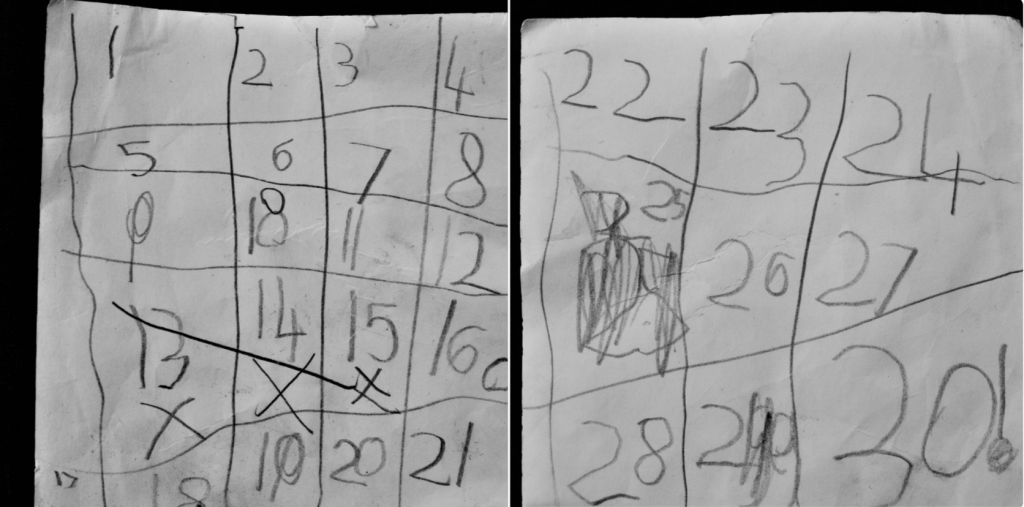 This example had the advantage of not looking polished, setting a low threshold for entry into grid creation, and giving status to unprompted creation. We looked at how he had divided the paper up into a grid and then filled it with numbers. I suggested that we could do our own, dividing it up however we liked and putting in whatever counting pattern we chose. We looked back briefly at what we would said about ways of counting, adding a few more thoughts:
This example had the advantage of not looking polished, setting a low threshold for entry into grid creation, and giving status to unprompted creation. We looked at how he had divided the paper up into a grid and then filled it with numbers. I suggested that we could do our own, dividing it up however we liked and putting in whatever counting pattern we chose. We looked back briefly at what we would said about ways of counting, adding a few more thoughts:
 We had a go on little whiteboards, and straight away there was a huge range of responses.
We had a go on little whiteboards, and straight away there was a huge range of responses.
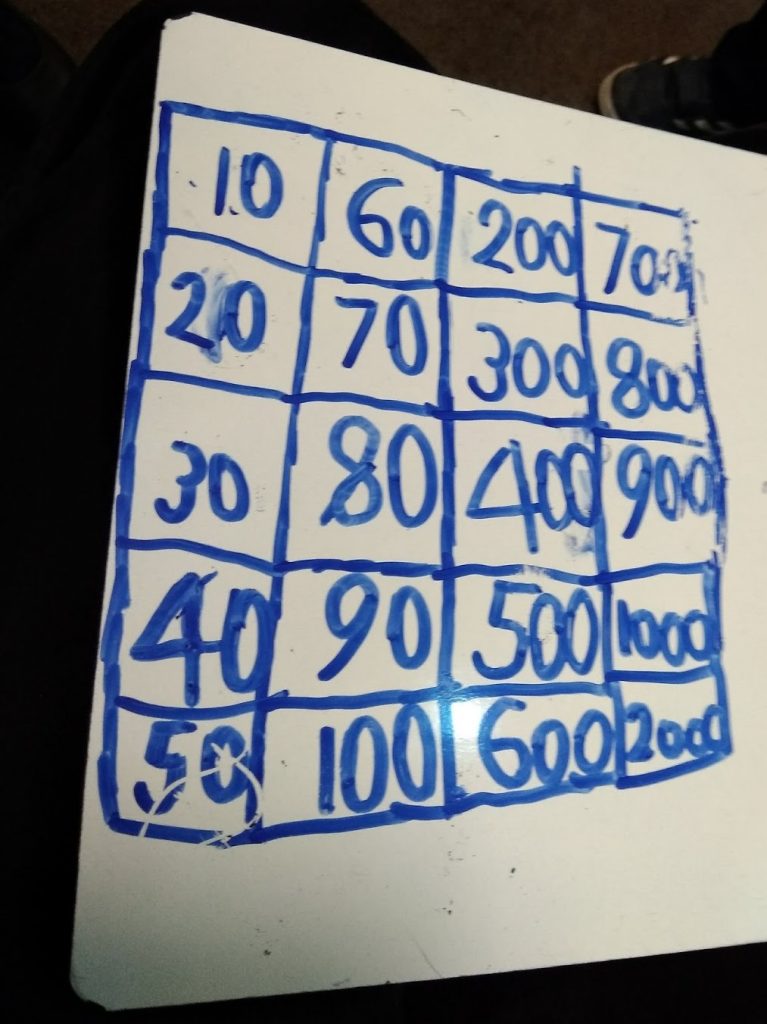
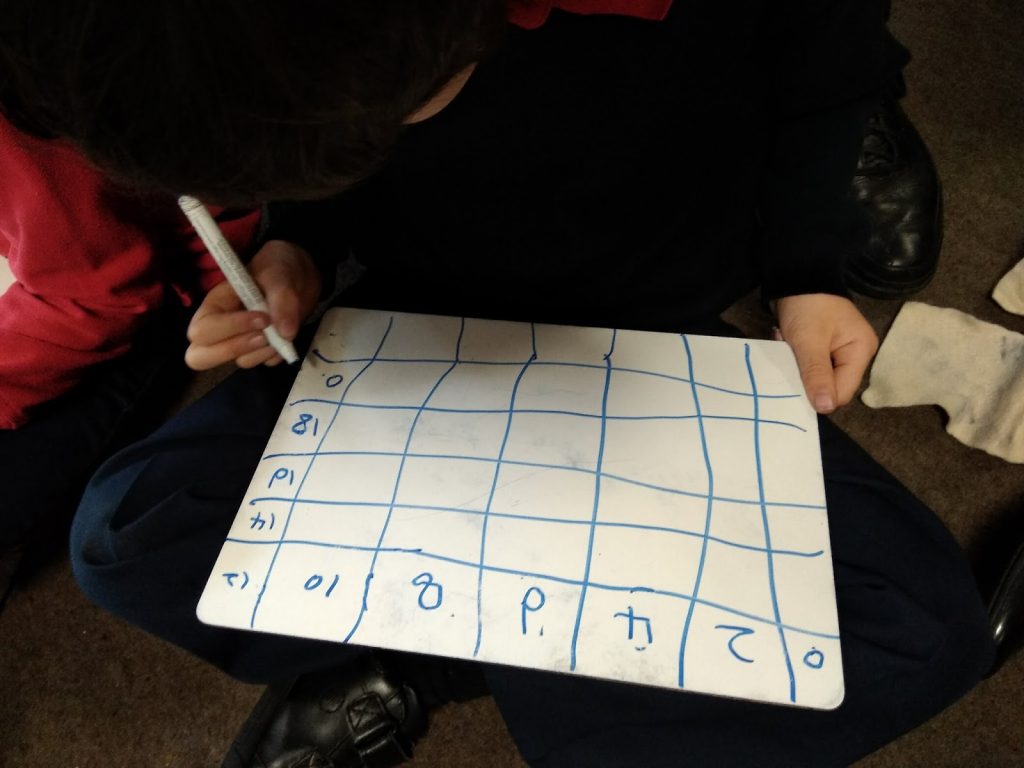
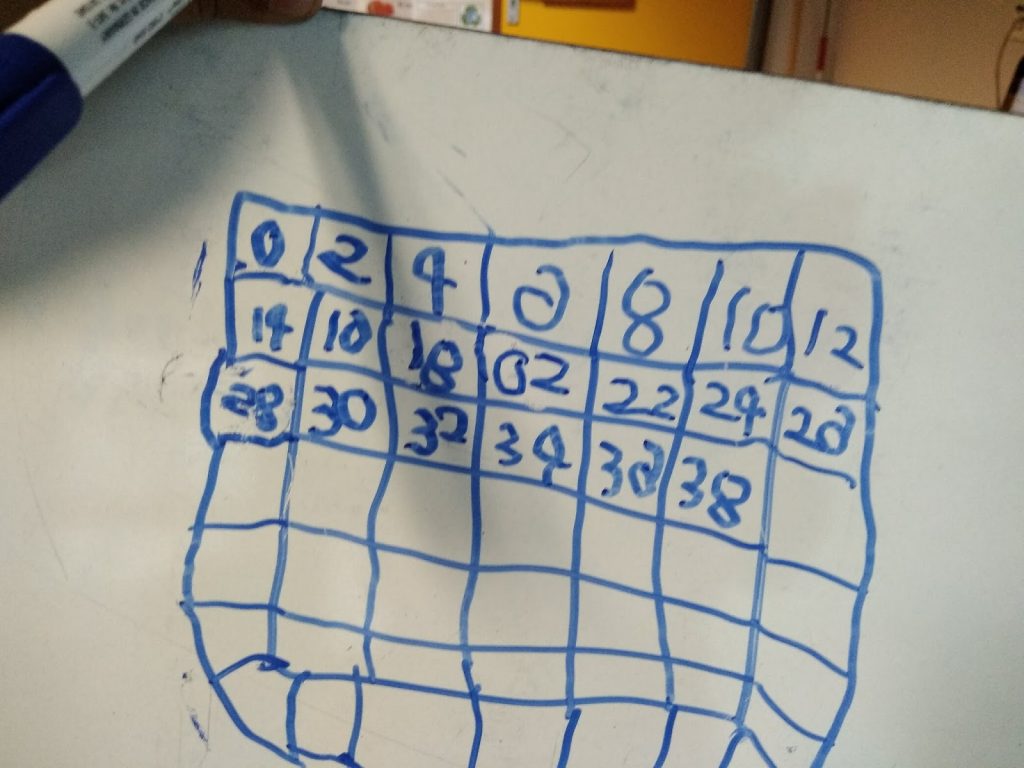 We were off school for a week at this point, so I invited the students to find a piece of paper at home and create their own grid, with whatever counting pattern shown in whatever way on it. Homework for us is only very occasional, but it can be a good way of getting even more variety. And this time it did. Back at school, we shared our grids in partners a number of times, and then went over them in felt-tip pen so they’d show when put up on the wall.
We were off school for a week at this point, so I invited the students to find a piece of paper at home and create their own grid, with whatever counting pattern shown in whatever way on it. Homework for us is only very occasional, but it can be a good way of getting even more variety. And this time it did. Back at school, we shared our grids in partners a number of times, and then went over them in felt-tip pen so they’d show when put up on the wall.
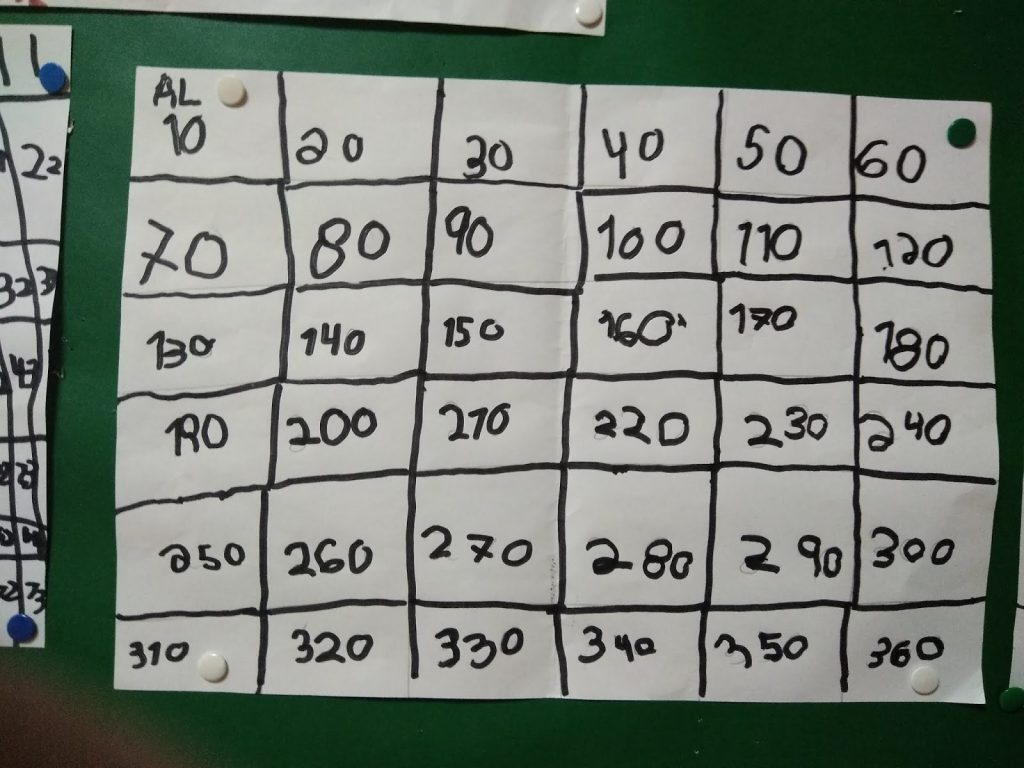
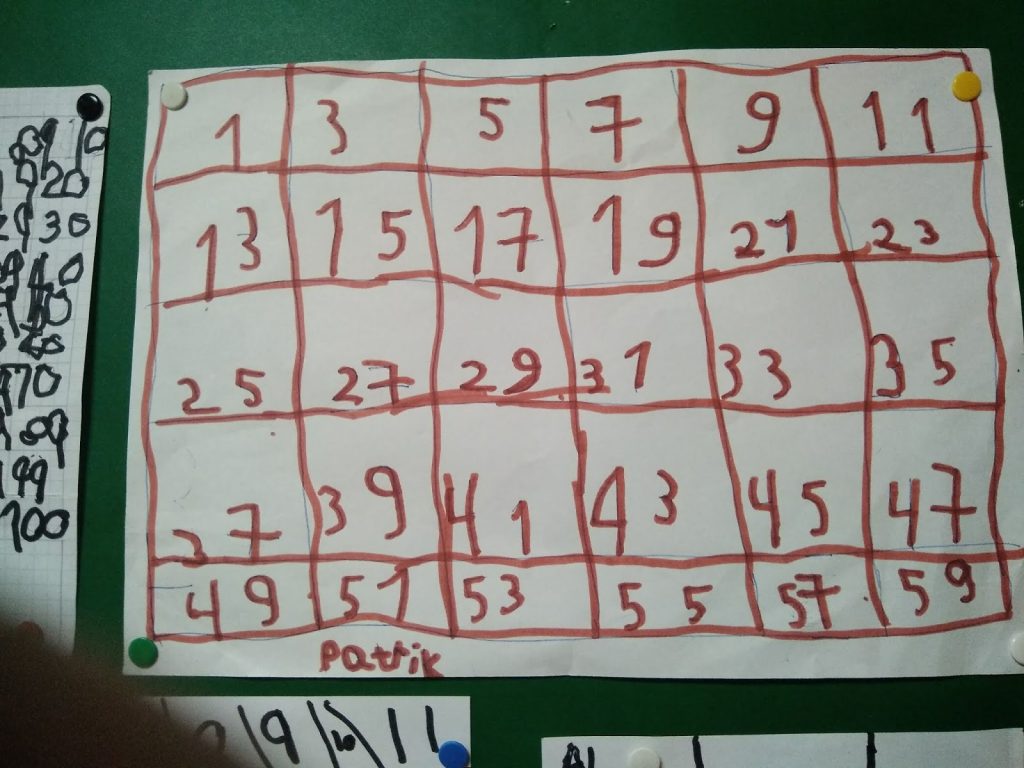
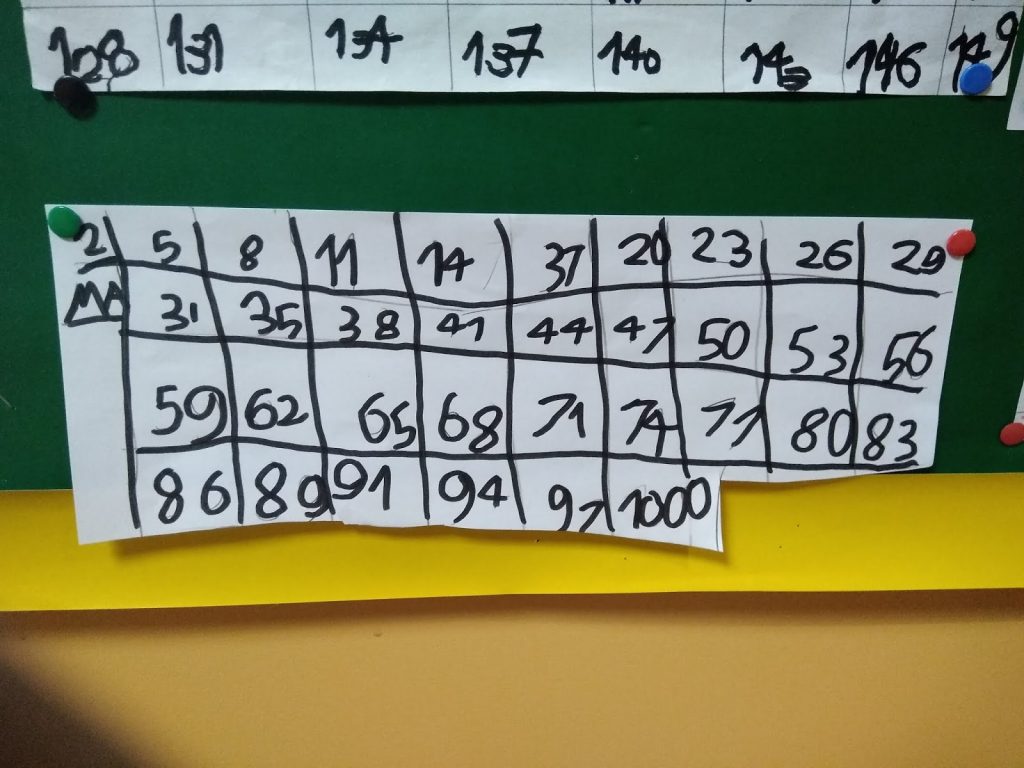 You can see more of our grids on our K3 blog.
You can see more of our grids on our K3 blog.
This was an opportunity for children to:
- see that mathematics is creative
- be inventive and think of their own way of doing things
- follow a rule
- arrange things carefully
- get to know different patterns of skip-counting
- show what they know.
It is clear from the exuberance of the students in creating these and their pride in showing their creations that they had certain attitudes in this work, particularly:
- commitment
- confidence
- cooperation
- creativity
- enthusiasm.
This seems like a very worthwhile trade-off for not knowing exactly where the inquiry is going, or that particular number patterns are covered by everyone. As a plus, there were many points of departure in their work for further inquiry. This grid for instance, a version of the so-called Gattegno Tens Chart (2014) is full of possibilities!
 Reference:
Reference:
Coles, A. 2014. Journeys on the Gattegno Tens Chart. Nrich website: https://nrich.maths.org/10314
Simon Gregg teaches in kindergarten at the International School of Toulouse, France. He is part of the mathematics committee at the school and loves exploring ways to make inquiring into mathematics a more meaningful and enjoyable experience. You can read more of Gregg’s thoughts on lessons on his personal blog Following Learning. Also you can follow him on Twitter @Simon_Gregg.

Great way to see patterns from the child’s point of view
Very captivating and really essential for kindergarten.
Excellent read! I love the way students are constructing and then transferring meaning.
Thank you Jason. Yes, seeing the learning from the child’s point of view – where they’re at in their understanding and what they enjoy – this is really essential!
An interesting read especially as I am about to begin teaching in K3. I’m looking forward to planning lessons following the ideas you so clearly explain here.